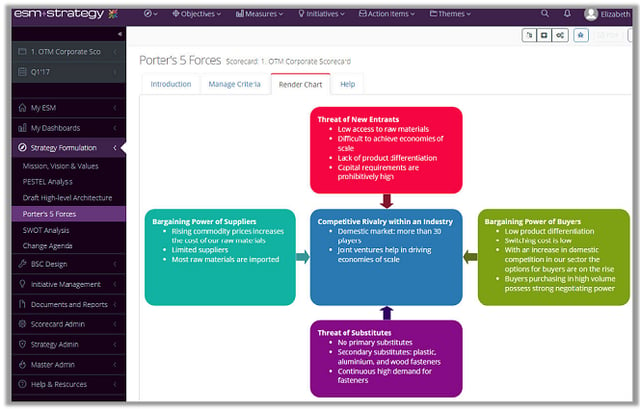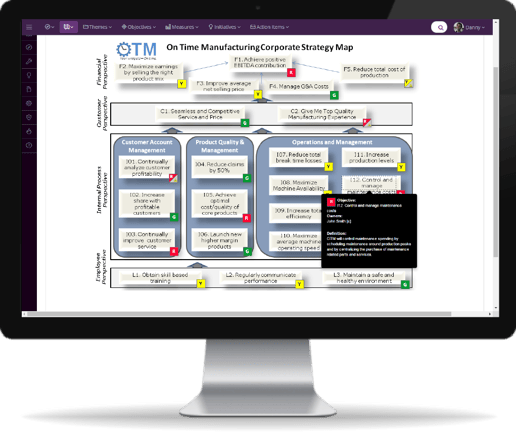Last week we reviewed the crucial components of a strategy meeting agenda. This week we examine the role of strategy software in execution. For starters, strategic planning software is an enabler and not a substitute for strategic planning. And, certainly not a substitute for strategic thinking.
Having said that, strategic planning software can provide a process guide, a tutorial and an organizing mechanism for your strategic planning exercise. But, remember, “software is not strategy” and it is not “strategic thinking."
Using the Kaplan and Norton approach to strategic planning process as an illustration, the software can guide the process steps in the strategic planning process:
1. Develop and/or Confirm the Foundation Statements – Mission, Vision and Values. Be sure to review these statements in the context of the organization’s current environment. Ensure that the statements serve the organization well over the Strategic Time Horizon (typically 3 to 5 years). Software can provide a guide to such development – definition of terms as well as examples. But Leadership must decide the definition and use of these foundation statements.
2. Define the Strategic Destination – this is the quantification of the Vision. The Strategic Destination serves as a point of reference for the rest of the planning process. The Strategic Destination is quantified (i.e. measured). Then Strategic Performance Gap can be defined as the difference between where you are today and where you want to be with the success of the strategic plan. Software can guide you with definitions and examples – such as the three steps in defining the strategic destination.
- Within X years,
- the (named organization) will be recognized as… (consistent with the Vision),
- as measured by (Measure and Target).
3. Environmental Scanning - Here is where the next process approach might deviate between different guru’s and organizations. Some will introduce this step earlier in the process but others will use this step to test the viability of steps 1 & 2. To establish the plan’s viability, a series of environmental scans needs to be done. Macro Scan (like PESTEL) and Micro Scans (like Industry Analysis (five forces), Competitor Analysis and Value Chain Analysis) can be conducted to define the context within which the plan must operate. Some have even used input from social media to inform their analysis at this point. If you compare the output of the Environmental Scans with the Quantified Strategic Destination you will better define the steps needed to have a differentiated strategy. Here software can enable each of these steps.

4. Defining the Change Agenda - having set the Foundation, the Strategic Destination and testing your assumptions against an Environmental Scan, decisions need to be made re the elements of the forward-looking plan. Here a tool like a “Change Agenda” can be used to identify things that need to change and define the change required (a from – to chart). The Change Agenda will be input to strategy development by defining what must be addressed in the strategic plan. Further, it can be used as input for Communication defining what must change to be successful.
5. Translate the Strategy with a Strategy Map - with Steps 1 through 4 done, the Strategic Plan is ready to be drafted. The Strategic outcomes, outputs and inputs that are needed to bring a plan into existence need to be articulated.
Using the Kaplan and Norton approach to strategy development – it is at this point that a Strategy Map can help define the strategy. Software here can provide templates that guide the format and linkages between the critical objective and initiative required to implement the strategy.
A Strategy Map is the first step in “translating the strategy into action”. Using the Strategy Map, the strategic outcomes will be defined and articulated in the Financial and Customer Perspective – generally three financial objectives and one overarching customer objective. Once agreed by the organization’s leaders, the next step is to define those objectives that will drive the outcomes – the critical work to be done to achieve the outcomes as defined. This is the internal process view of the strategy, some define as “organizational competence - what must we do well to deliver the customer and financial outcomes?” Generally, there are three to four high priority Themes/Objectives – outputs linked to the delivery of the outcomes first in the customer perspective and then in the financial perspective. Finally, when “what you must do well” is defined (internal objectives), the critical enablers need to be defined – Skills, Knowledge, Culture and Technological enablers needed to do the work is defined. Software, like that developed by ESM Group under the guidance of Kaplan and Norton, can assist in this task by providing templates and tutorials on Strategy Map Design and Development.

6. Measures and Targets - Once the Strategy Map is approved by the organization’s leaders, measure and targets are assigned so future performance can be evaluated. Reporting software can record progress and map achievement of each element of the strategy map over time – quarterly, annually, and over the strategic time horizon. in the Kaplan and Norton approach to strategy implementation, you will measure two things: the performance against each objective (traditional variance reporting) and correlation (and maybe causation) between the linked objectives. Here software can be a tremendous advantage by automating the data collection and reporting process from existing systems. With enough data, it may provide the analytics for correlation or causation providing insights that tests you hypothesis of cause and effect. This will reduce the burden and pain of strategic plan administration. But the real benefit of the automated reporting system is the ability to free up Subject Matter Expert’s time for the critical task of interpreting the data and making recommendations for adaptive actions.
7. Initiatives – the projects that change the organization. Strategic Initiatives are the projects or programs needed to change the organization to be able to achieve the strategic objectives. Typically, there are from 5 to 10 Strategic Initiatives linked to the Strategy. They generally represent 20% of the project spend in any organization (the 80% spend is tied to operational or tactical initiatives intended to update, maintain and enhance current operations). Software here is generally available in the Project Management Office. It will have approved templates for Initiative definition, business case, project roadmap and financials (both cost and ROI). What is critical here is that the Strategic Initiatives are defined, planned, justified and monitored by the leadership team.
8. Monitoring and Reporting – the most direct use of software is used in the comprehensive monitoring of performance and ongoing reporting. As mentioned previously, a software package that is user friendly and provides for distributed input whether by individuals or through existing systems (e.g. Financial or HRIS Systems) allows the organization to stay on top of performance, trends and potential changes in the environment. It is here where there is an increasing use of social media inputs (particularly in the Customer and Employee areas) where software can be highly leveraged.
Software is an enabler that can be applied to most every aspect of Strategic Planning and Strategy Execution. The caution here is let the process you design define the technology and not the other way around.








